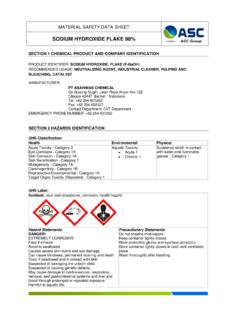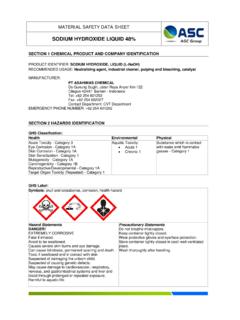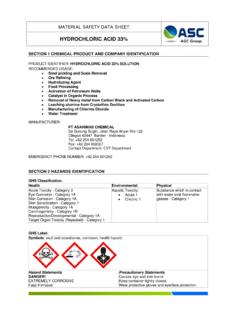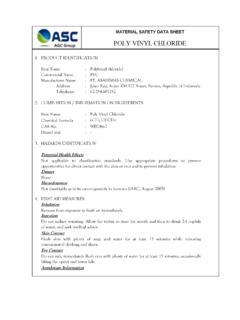Transcription of SODIUM HYPOCHLORITE 10% - Asahimas Chemical
1 material safety data sheet . SODIUM HYPOCHLORITE 10%. SECTION 1 Chemical PRODUCT AND COMPANY IDENTIFICATION. PRODUCT IDENTIFIER: SODIUM HYPOCHLORITE SOLUTION. RECOMMENDED USAGE: BLEACHING AGENT ; DESINFECTANT ; WATER TREATMENT ;. DEODORIZER, SOURCE OF AVAILABLE CHLORINE. MANUFACTURER: PT Asahimas Chemical . Ds Gunung Sugih, Jalan Raya Anyer Km-122. Cilegon 42447 Banten - Indonesia Tel: +62 254 601252. Fax: +62 254 602027. Contact Department: CVT Department EMERGENCY PHONE NUMBER: +62 254 601252. SECTION 2 HAZARDS IDENTIFICATION. GHS Classification: Health Environmental Physical Acute Toxicity - Category 3 Aquatic Toxicity: Substance which in contact Eye Corrosion - Category 1A Acute 1 with water emit flammable Skin Corrosion - Category 1A Chronic 1 gasses - Category 1. Skin Sensitization - Category 1.
2 Mutagenicity - Category 1A. Carcinogenicity - Category 1B. Reproductive/Developmental - Category 1A. Target Organ Toxicity (Repeated) - Category 1. GHS Label: Symbols: skull and crossbones, corrosion, health hazard Hazard Statements Precautionary Statements DANGER! Do not get in eyes, on skin, or on clothing. EXTREMELY CORROSIVE Do not breathe mist. IRRITANT Keep container closed. Harmful if SWALLOWED or INHALED. Use only with adequate ventilation. Causes severe skin burns and eye damage. Wash thoroughly after handling. Can cause blindness, permanent scarring and death. Toxic if swallowed and in contact with skin Suspected of damaging the unborn child. Suspected of causing genetic defects. May cause damage to cardiovascular, respiratory, nervous, and gastrointestinal systems and liver and blood through prolonged or repeated exposure.
3 Harmful to aquatic life. material safety data sheet . SODIUM HYPOCHLORITE 10%. SECTION 3 COMPOSITION, INFORMATION ON INGREDIENTS. Chemical IDENTITY: SODIUM HYPOCHLORITE SOLUTION 10%. TRADE NAMES/SYNONYMS: BLEACH; HYPOCHLOROUS ACID, SODIUM SALT; SODA BLEACH; SODIUM OXYCHLORIDE;. JAVEL WATER; HYPO; HOUSEHOLD BLEACH; INDUSTRIAL BLEACH; LIQUID CHLORINE. CAS NUMBER: 7681-52-9. EC NUMBER (EINECS): 231-668-3. EC INDEX NUMBER: MINIMUM PERCENTAGE: 10. SECTION 4 FIRST AID MEASURES. INHALATION: Remove to fresh air. If not breathing, give artificial respiration. If breathing is difficult, give oxygen. Get medical attention immediately. SKIN CONTACT: Immediately flush skin with plenty of water for at least 15 minutes while removing contaminated clothing and shoes. Get medical attention immediately. Wash clothing before reuse.
4 Thoroughly clean shoes before reuse. EYE CONTACT: Immediately flush eyes with plenty of water for at least 15 minutes, lifting lower and upper eyelids occasionally. Get medical attention immediately. INGESTION: If swallowed, DO NOT INDUCE VOMITING. Give large quantities of water. Never give anything by mouth to an unconscious person. Wash mouth with water, then give plenty of milk or water to drink and obtain urgent medical attention. NOTE TO PHYSICIAN: Consider oral administration of SODIUM thiosulfate solutions if SODIUM HYPOCHLORITE is ingested. Do not administer neutralizing substances since the resultant exothermic reaction could further damage tissue. Endotracheal intubation could be needed if glottic edema compromises the airway. For individuals with significant inhalation exposure, monitor arterial blood gases and chest x-ray.
5 SECTION 5 FIRE FIGHTING MEASURES. FIRE HAZARD: Not considered to be a fire hazard. Substance releases oxygen when heated or reach with some metals, which may increase the severity of an existing fire. Containers may rupture from pressure build-up. EXPLOSION HAZARD: This solution is not considered to be an explosion hazard. Anhydrous SODIUM HYPOCHLORITE is very explosive. SUITABLE EXTINGUISHING MEDIA: Use any means suitable for extinguishing surrounding fire. Use water spray to cool fire-exposed containers, to dilute liquid, and control vapor. SPECIAL INFORMATION: In the event of a fire, wear full protective clothing and NIOSH-approved self-contained breathing apparatus with full facepiece operated in the pressure demand or other positive pressure mode. SECTION 6 ACCIDENTAL RELEASE MEASURES. - PERSONAL PRECAUTIONS: Wear appropriate personal protective equipment as specified in Section 8.
6 - ENVIRONMENTAL PRECAUTIONS: Ventilate area of leak or spill. Isolate hazard area. Keep unnecessary and unprotected personnel from material safety data sheet . SODIUM HYPOCHLORITE 10%. entering. Contain and recover liquid when possible. - METHODS & MATERIALS FOR CONTAINMENT & CLEANING UP. Collect liquid in an appropriate container or absorb with an inert material (e. g., vermiculite, dry sand, earth), and place in a Chemical waste container. Do not use combustible materials, such as saw dust. Do not flush to sewer! US Regulations (CERCLA) require reporting spills and releases to soil, water and air in excess of reportable quantities. SECTION 7 HANDLING AND STORAGE. - PRECAUTIONS FOR SAFE HANDLING: Use proper equipment for lifting and transporting all containers. Use sensible industrial hygiene and housekeeping practices.
7 Wash thoroughly after handling. Avoid all situations that could lead to harmful exposure. Avoid contact with eyes and skin. - PRECAUTIONS FOR SAFE STORAGE (including any incompatibilities): Keep in a tightly closed container, stored in a cool, dry, ventilated area. Protect against physical damage. Isolate from incompatible substances. Containers of this material may be hazardous when empty since they retain product residues (vapors, liquid); observe all warnings and precautions listed for the product. Do not store near acids, heat, oxidizable materials or organics. SECTION 8 EXPOSURE CONTROLS, PERSONAL PROTECTION. - CONTROL PARAMETERS: OCCUPATIONAL EXPOSURE LIMIT or BIOLOGICAL LIMIT VALUE: Airborne Exposure Limits: - AIHA (WEEL) - SODIUM HYPOCHLORITE : 2 mg/m3 (STEL). - OSHA Permissible Exposure Limit (PEL) - SODIUM Hydroxide: 2 mg/m3 Ceiling Chlorine (from SODIUM HYPOCHLORITE ): ppm (TWA), 1 ppm (STEL).
8 - ACGIH Threshold Limit Value (TLV) - SODIUM Hydroxide: 2 mg/m3 Ceiling Chlorine (from SODIUM HYPOCHLORITE ): ppm (TWA), 1 ppm (STEL), A4. - APPROPRIATE ENGINEERING CONTROLS: Ventilation System: A system of local and/or general exhaust is recommended to keep employee exposures below the Airborne Exposure Limits. Local exhaust ventilation is generally preferred because it can control the emissions of the contaminant at its source, preventing dispersion of it into the general work area. Please refer to the ACGIH. document, Industrial Ventilation, A Manual of Recommended Practices, most recent edition, for details. PERSONAL PROTECTIVE EQIPMENT. PERSONAL RESPIRATORS (NIOSH APPROVED): If the exposure limit is exceeded, a full facepiece respirator with an acid gas cartridge may be worn up to 50. times the exposure limit or the maximum use concentration specified by the appropriate regulatory agency or material safety data sheet .
9 SODIUM HYPOCHLORITE 10%. respirator supplier, whichever is lowest. For emergencies or instances where the exposure levels are not known, use a full-facepiece positive-pressure, air-supplied respirator. WARNING: Air purifying respirators do not protect workers in oxygen-deficient atmospheres. SKIN PROTECTION: Wear impervious protective clothing, including boots, gloves, lab coat, apron or coveralls, as appropriate, to prevent skin contact. EYE PROTECTION: Use Chemical safety goggles and/or a full face shield where splashing is possible. Maintain eye wash fountain and quick-drench facilities in work area. SECTION 9 PHYSICAL AND Chemical PROPERTIES. APPEARANCE: PHYSICAL STATE: Clear Liquid. COLOR: Banana-colored ODOR: Pungent, chlorine-like odor. ODOR THRESHOLD: Not available Molecular Weight: Chemical Formula: NaOCl pH: (11-13).
10 MELTING POINT: (0F). BOILING POINT: (219F). FLASH POINT: Not available EVAPORATION RATE (BuAc=1): Not applicable. (Similar to water). FLAMMABILITY (solid, gas): Not available VAPOR PRESSURE (mm Hg): @ 50C. VAPOR DENSITY (Air=1): Not applicable. SPECIFIC GRAVITY: ( ). SOLUBILITY IN WATER: Completely soluble % Volatiles by volume @ 21C (70F): Decompose leaving salt solution. PARTITION COEFICIENT n-octanol / water: Not available AUTO-IGNITION TEMPERATURE: Not available DECOMPOSITION TEMPERTURE: Not available SECTION 10 STABILITY AND REACTIVITY. - Chemical STABILITY: Slowly decomposes on contact with air. Rate increases with the concentration and temperature. Exposure to sunlight accelerates decomposition. SODIUM HYPOCHLORITE becomes less toxic with age. - CONDITIONS TO AVOID: Light, heat, air and incompatibles.




